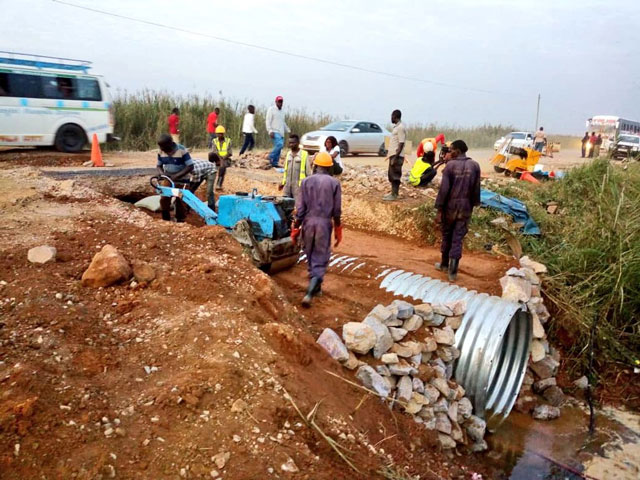
Engineers Blame Masaka Road Defects to Poor Construction, Delayed Maintenance
Masaka, Uganda | THE INDEPENDENT | Engineers have pointed to poor construction and delayed maintenance as the likely causes of the defects being experienced on Masaka-Kampala highway barely six years after its reconstruction.
The road caved in at Lwera near Lukaya town and Uganda National Roads Authority (UNRA) engineers Saturday worked overnight to restore at least one side of the road to enable traffic flow. The other side is expected to be completed today.
This eased the nasty experience of long delays involving travelers plying the western route, most of those returning from the countryside after celebrating Christmas. On Saturday night, hundreds of travelers spent several hours on the road after it caved in.
Travelers have now been urged to also seek alternative routes to Kampala.
“From Mbarara however, you can turn off at Nyendo, head to Villa Maria and onto our Project of Mpigi-Kanoni-Sembabule-Villa Maria which is tarmac, ” said UNRA Spokesperson Mark Ssali.
Prior to the Saturday experience, several defects had been recorded on the same road, which was upgraded to Grade II bituminous surface in 2013 at the tune of Shillings 103 billion. The first major defect was reported in the Lwera section still.
Traffic Jam in Lwela , we have been stuck here for almost 40mins , if you know an alternative route use that @observerug pic.twitter.com/YAJ7XE8MyX
— Nicholas Bamulanzeki (@bamulanzeki) December 29, 2019
On assessing the situation, Engineers from Uganda National Roads Authority-UNRA who initially thought that the culverts could had been compressed were extremely surprised to find that the road was burnishing underneath. A similar incident happened in Kalandazi section last month.
Badru Kiggundu, a seasoned Civil Engineer, Academic and Consultant, says most of the defects that manifest reflect the mistakes that could have been done during the designing or construction phases. He says while designing a road, every aspect is looked at even giving room for possible future changes but this couldn’t have been catered for.
According to Eng Kiggundu, the reported scouring and curving could be due to subsurface water, which might have not been anticipated in the construction and is now flowing into the structure of the road eating away some components including the roadbed. He says during the design stage there should be strong design features put in place to handle such incidents.
Sam Mwesigwa, another proficient Engineer in Wakiso, notes that the designers could have failed to put appropriate features in areas where they were needed. He cites a number of wetland sections, which might require a strong base to sustain pressure.
Eng. Kiggundu, who fairly agrees with Mwesigwa, notes that he cannot blame engineers given the fact that the contractor could have needed bigger culverts but used smaller ones because of limited resources.
The question of culvert used by the contractor was also highlighted by UNRA highway specialist Moses Ochole during a stakeholder’s meeting in Greater Masaka. Ochole observed that there are possibilities that the contractor unknowingly used faulty culverts.
The road works done in two phases was executed by Reynolds Construction Company-RCC. In the same development, Eng. Mwesigwa also points to delayed maintenance of the road as another challenge. He says there is need for regular maintenance given the huge traffic and weather changes.
It was not until defects appeared that UNRA started clearing some of the sections, which had narrowed due to the growing vegetation on the roadside. In a recent interview, Allan Ssempwewa, the UNRA Media Manager told this reporter that they (UNRA) were looking at the possibility of accessing the entire road to look out for areas that need urgent attention for redress before more damage is done.
Road users are blaming the defects on people farming and mining sand in the wetland where most of the affected sections are found. Isaac Mugerwa, a motorist notes that the activities have affected the water flow and thus weakened the road.
“Left and right people are destroying the wetland ad I end water can flow thus flooding at one particular point ad in end the road will just curve in,” Mugerwa says adding that the worst fear is that the road tens to curve in during light which put road user at risk as they can unknowingly bump into the pothole.
*****
URN
 The Independent Uganda: You get the Truth we Pay the Price
The Independent Uganda: You get the Truth we Pay the Price



It’s disappointing that roads that take lots of monies cannot last a decade.
A number of issues have to be observed especially during civil works and key is ongoing supervision by a team of long serving local engineers who are acquainted with the climatic conditions of areas through which the road traverses, those are able to project the weathering effects on the road and thus advise on proper materials to use.
Also and most importantly is the proper use and abuse of the road by traffic and those who live and work within the road vicinity, there should be an ongoing campaign by UNRA through its highway maintenance crew, if present at all and if not, that long overdue, to not curb overweight traffic, but to educate and encourage proper use of roads, road reserves, and scheduled and off schedule road and road furniture maintenance.
It is sad to note even newly constructed or upgraded roads deteriorate, when forexample a simple de-silting of trenches could save an entire road section.
Change in land use. esp the economic activities that are emerging in the area esp rice planting,sand extraction and roof cover new emerging buildings that change water that would infiltrate into soil to instead flow to areas of low altitudes.
IF we had funds, we would have a flyover over that area. because being a wetland, water is settling there anytime